
* The Piasecki company had established itself on the basis of its tandem rotor helicopter designs. By the late 1950s, the company -- renamed "Vertol", soon to become "Boeing Vertol", had refined that design concept, developing the "CH-46 Sea Knight", which would have a long-lived career with the US Marines, US Navy, and a few foreign users.
* In 1956, Vertol began studies for a new medium-lift helicopter, with the general configuration of the company's "HUP-1 Retriever / H-25 Mule" helicopter and based on the rotor system of the company's "H-21 Flying Banana", but fitted with new lightweight turboshaft engines then in development. The new machine was given the company designation of "Vertol Model 107 (V-107)", and company management decided to go ahead with development using their own funds.
Construction of the V-107 prototype began in May 1957. The prototype was powered by two Lycoming T53 turboshaft engines, each with 640 kW (860 SHP) and lent by the US Army. Initial flight of the prototype was on 22 April 1958. The machine was then put through an intensive program of flight demonstrations in the US and overseas. In June 1958, the Army awarded a contract to Vertol for ten production aircraft designated "YHC-1A".
The Army also issued a request to industry for a larger helicopter, and so Vertol began design work on what amounted to a scaled-up version of the V-107, designated the "V-114". The V-114 won the Army competition in March 1959, and Vertol was awarded a contract for a mockup and five prototypes, to be designated the "YHC-1B".
Vertol was now busy trying to develop two helicopters at the same time, which severely stressed the company and led to the Boeing buyout. The number of YHC-1A prototypes was reduced to three to free up resources for YHC-1B development. The first flight of the initial YHC-1B prototype was on 21 September 1961.
The Army had lost interest in the smaller YHC-1A, and the three prototypes were the only rotorcraft in the series the Army ever funded. Boeing Vertol still felt there was a market for it, and continued development. The US Marine Corps was impressed by the machine and awarded the company a production contract in February 1961. The Marines originally wanted to give the V-107 the military designation of "HRB-1", but in September 1962 the Pentagon introduce a new "tri-service" uniform designation scheme. The HRB-1 became the "CH-46A Sea Knight", while the HC-1B became the "CH-47A Chinook", discussed in the next chapter. The five V-114 prototypes became "YCH-47As".
At least some of the YHC-1B prototypes, incidentally, were put to use by Boeing in trials. A photo survives of one fitted with short rectangular fore and aft wings -- a fit that was never adopted for service.
BACK_TO_TOP* Initial flight of a full-specification CH-46A was on 16 October 1962, and the type went into operational service with the Marines in June 1964. The service obtained a total of 160 CH-46As. Although initially there was suspicion of the type since the Marines were accustomed to Sikorsky helicopters, the Sea Knight quickly proved itself in Vietnam after its introduction into the theater in 1966.
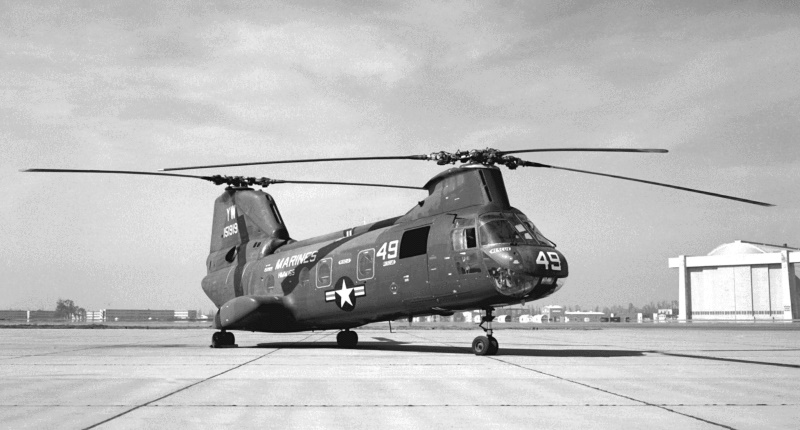
The CH-46A had the contra-rotating tandem rotor configuration of its Piasecki HUP Retriever ancestor. The two T58-GE8-8B turboshaft engines, providing 930 kW (1,250 SHP) each, were fitted on either side of the rear rotor pedestal. A driveshaft ran to the forward rotor; either of the two engines could run both rotors in an emergency. The three-bladed rotors had a power-folding scheme for shipboard storage, though some other Sea Knight variants would delete this feature and use manually-folding rotors instead.
The cargo bay had a rear loading ramp that could be removed or left open in flight for long cargoes or for parachute drops, plus a winch system and rollers in the floor to help cargo loading. A belly sling hook for external loads could be installed through a cargo hatch in the floor. There was a split passenger door on the right side, with built-in steps on the bottom half. The CH-46A had a crew of three, and could carry 17 troops; or 15 litters with two attendants; or 1,815 kilograms (4,000 pounds) of cargo. A pintle mount for a machine gun was fitted on each side of the machine for a self-defense capability. It appears that early on, the Browning M2 12.7-millimeter (0.50-caliber) machine gun was the usual armament fit, but later it would be the M240 / MAG 7.62-millimeter (0.30-caliber) machine gun.
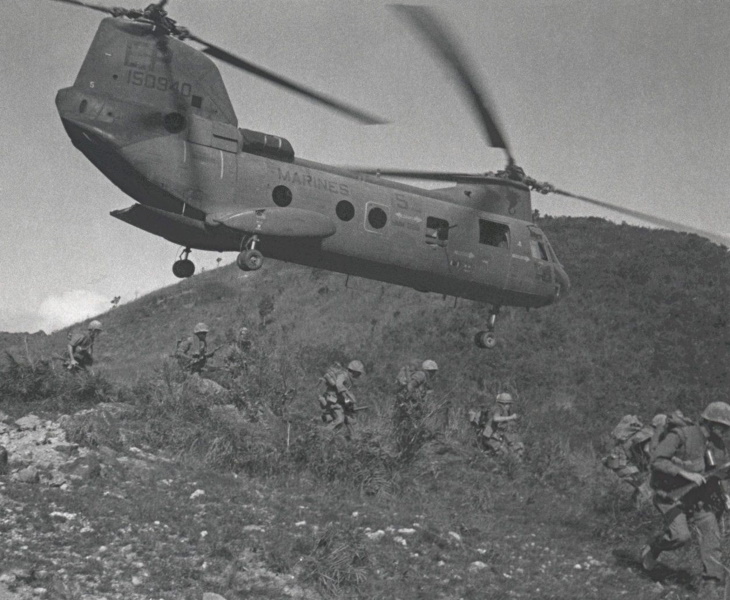
The CH-46A had fixed tricycle landing gear, with twin wheels on all three units. The main gear was fitted in rear sponsons that also contained self-sealing fuel tanks with a total capacity of 1,438 liters (350 US gallons). Some Sea Knight variants would also be fitted with auxiliary external tanks on the end of the sponsons, as discussed below. The gear configuration gave the machine a nose-up attitude that made cargo easier to load and unload. Skis could be fitted to the landing gear for operation on snow and marshy ground. The Sea Knight could float on calm waters in an emergency, though it wasn't really an amphibian.
___________________________________________________________________
BOEING-VERTOL CH-46A SEA KNIGHT:
___________________________________________________________________
rotor diameter:
15.24 meters (50 feet)
fuselage length:
13.66 meters (44 feet 10 inches)
footprint length:
25.40 meters (83 feet 4 inches)
height (rotor head):
5.09 meters (16 feet 9 inches)
empty weight:
5,625 kilograms (12,405 pounds)
max loaded weight:
9,705 kilograms (21,400 pounds)
maximum speed:
256 KPH (159 MPH / 138 KT)
service ceiling:
4,265 meters (14,000 feet)
range:
370 kilometers (265 MI / 230 NMI)
___________________________________________________________________
CH-46A production was followed by 266 "CH-46D" machines, with initial delivery in September 1966. The primary improvements were uprated T58-GE-10 turboshaft engines with 1,045 kW (1,400 SHP) each, and modified rotor blades. The greater power allowed the CH-46D to lift 25 troops or 3,175 kilograms (7,000 pounds) of cargo. About 12 CH-46As were also updated to the CH-46D standard. The final Boeing production model was the "CH-46F", with 174 obtained by the USMC from July 1968 to February 1971; the CH-46F retained the T58-GE-10 turboshafts, but had revised avionics and other modifications.
The sponsons and the nose-up attitude of the CH-46 on the ground gave the appearance of a frog ready to hop, and so the Marines nicknamed the type the "Frog" -- often rendered as "Phrog", it appears as a nod to its use in "amPHibious" operations. The CH-46 fleet was grounded for a time in 1967 when a few of them were lost in accidents. The Frogs acquitted themselves well in combat, particularly during the siege of Khe Sanh in early 1968. CH-46s also served in the evacuation of Saigon in 1975.
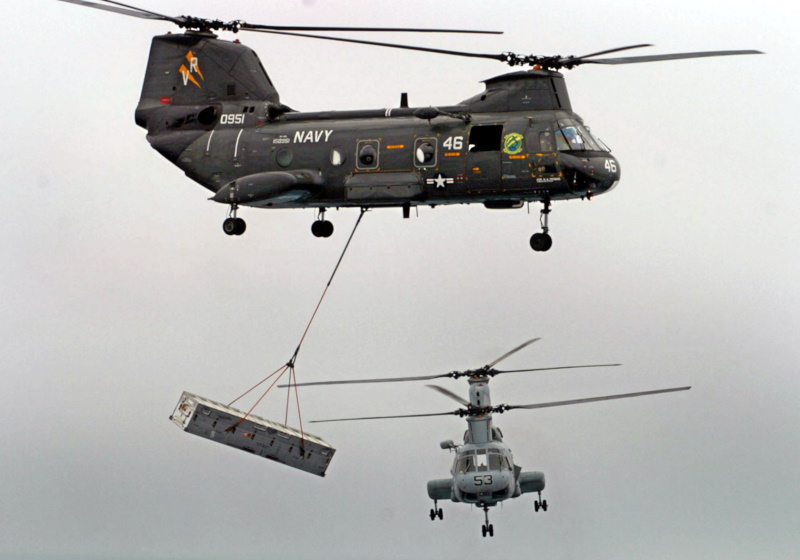
The US Navy also acquired the Sea Knight, though in smaller numbers, beginning with 24 "UH-46A" shipboard resupply ("vertical replenishment / vertrep") helicopters. Initial delivery of the UH-46A was in July 1965. This order was followed by ten "UH-46D" machines, with five UH-46As also updated to this configuration. Some sources mention "HH-46A" and "HH-46D" variants for "search and rescue (SAR)", as well as an "RH-46" minesweeper.
* The Sea Knight proved very long-lived in service. After Vietnam, it saw action with the Marines in Lebanon, Grenada, and elsewhere. A number of CH-46Fs were also used by HMX-1, the US Marine presidential flight, as support (not VIP) helicopters and designated "VH-46F".
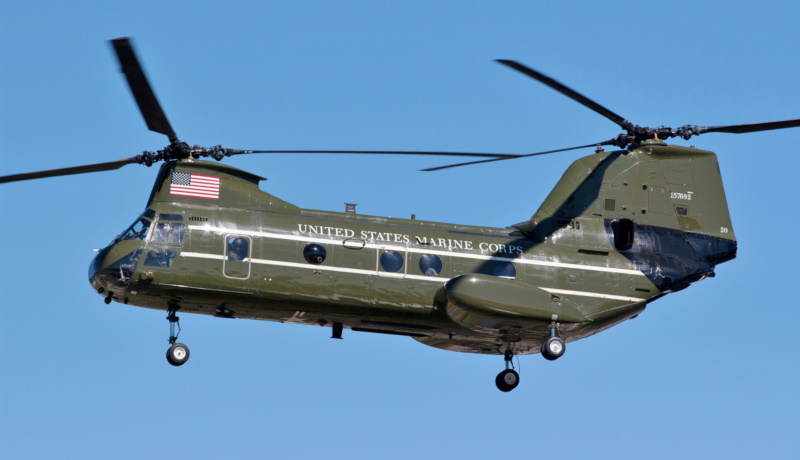
The type went through a number of upgrades and conversions, with most Marine machines finally brought up to "CH-46E" standard. The CH-46E featured fiberglass rotor blades, airframe reinforcement, and further uprated T58-GE-16 engines with 1,395 kW (1,870 SHP) each. Some were given doubled fuel capacity, and nicknamed "Bullfrogs".
Fiberglass rotor blades were also fitted to US Navy Sea Knights, and many Sea Knights in foreign service. During the 1980s, the Marine and Navy Sea Knight fleets were given a broad set of updates through the "Safety, Reliability, & Maintainability (SR&M)" program; late in the decade they were also given an airbag flotation system to improve their seaworthiness. Marine Sea Knights were fitted with countermeasures, including missile warning systems and chaff-flare dispensers, as well as ultimately the Northrop-Grumman "Directed Infrared Countermeasures (DIRCM)" system, which used lasers to dazzle heat-seeking missiles. Some were also fitted with a flexible mount for a MAG machine gun on the tail ramp to provide covering fire on exit from a landing zone.
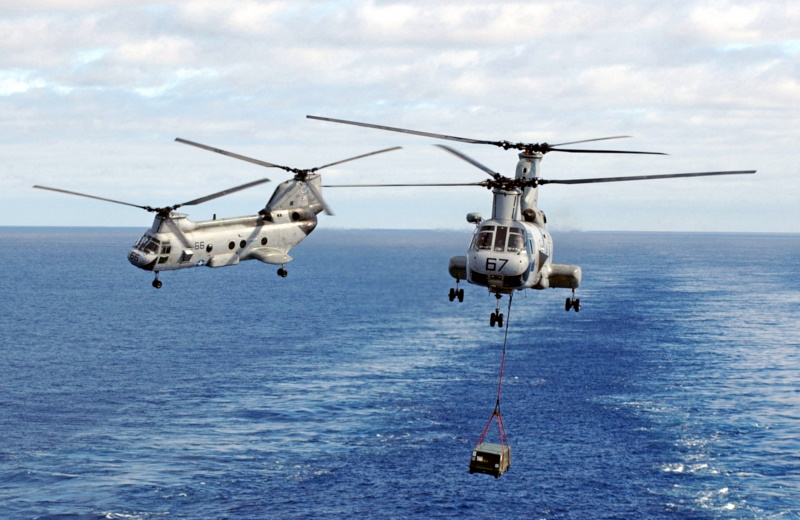
The US Navy, confronted with rising costs for keeping the service's venerable UH-46s in the air, phased them out, with the last machines retired in the fall of 2004. They were replaced with the Sikorsky MH-60S Knighthawk, a new variant of the Sikorsky Blackhawk / Seahawk family.
The Marines were slower to get rid of the Frog; they wanted to replace it with the Bell-Boeing "MV-22 Osprey" tilt-rotor transport, but the Osprey program ran into delays. To keep the USMC's CH-46s in service until the Osprey could take up the load, the Marines implemented an upgrade program, replacing metal armor with a new lightweight armor to increase the helicopter's lift capacity; and then performed a second upgrade to improve the serviceability of the helicopter's T58 turboshafts, with the upgraded engines designated "T58-GE-16A".
The last USMC CH-46s were finally retired in 2015. Several dozen were passed on to the US State Department's Air Wing, though it appears many were just used as spares hulks. Seven flew in the frantic evacuation from Kabul, Afghanistan, in 2021, with one of them having evacuated the US embassy in Saigon in 1975. The seven were abandoned and trashed at the end of the evacuation.
BACK_TO_TOP* Boeing built 17 "V-107/II" machines for commercial service, fitted with General Electric CT58-110-1 turboshafts with 1010 kW (1,350 SHP) each. They were available in an airliner format, with passenger seating and a rollout baggage compartment -- or in a cargolifter format, with a rear loading ramp like the military versions of the helicopter.
One of the three YHC-1A prototypes was modified to serve as the V-107/II prototype, performing its first flight on 25 October 1960. The first of 17 production V-107/IIs performed its initial flight on 19 May 1961, with the type receiving US Federal Aviation Administration (FAA) certification in January 1962. Seven of the V-107/IIs were operated by New York Airways, the first of them going into service on 1 July 1962. The other ten were sold to Kawasaki of Japan as a prelude to Japanese license construction of the type, as discussed below.
* Boeing sold a total of 18 Sea Knights to Canada, beginning with six "CH-113 Labradors" delivered to the Royal Canadian Air Force for SAR duties in 1963 and 1964. They were basically CH-46A helicopters with a search radar radome in the nose, and external auxiliary fuel tanks. The Canadian Army also obtained 12 "CH-113A Voyageurs" in 1964:1965, these machines being close to stock CH-46As.
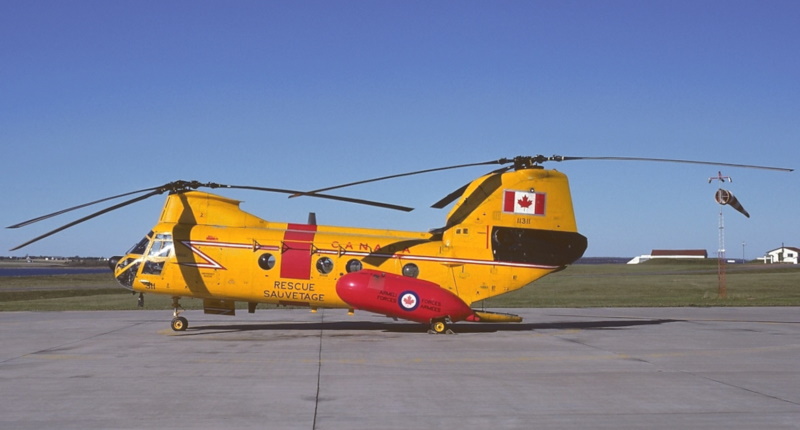
The surviving Canuck Sea Knights were given a comprehensive update by Boeing Canada in the mid-1980s. Canadian Sea Knights were tasked with the SAR mission, but were finally withdrawn in 2004, with eight sold to a civilian operator and two placed in museums.
* Following the signing of a license agreement in early 1962, Kawasaki of Japan took up production of the V-107/II, under the designation of "KV-107/II". The first Kawasaki-built Sea Knight flew in May 1962. In 1965, Kawasaki signed a follow-on agreement with Boeing that allowed the Japanese company to sell the helicopter on the world market. All commercial sales of the Sea Knight after that time were from Kawasaki production.
The KV-107/II series was fitted with by twin General Electric CT58-110-1 turboshaft engines, or equivalent license-built Ishikawajima-Harima CT58-IHI-110-1 engines. Subvariants included:
Kawasaki then went on to develop a "KV-107/IIA" series with uprated CT58-140-1 or CT58-IHI-140-1 turboshafts, providing 1,045 kW (1,400 SHP) each. Boeing assisted in qualification of the new series. A number were built for the Japanese military:
The SDF KV-107s are now out of service, many of them having been replaced by Kawasaki-built CH-47s, discussed later.
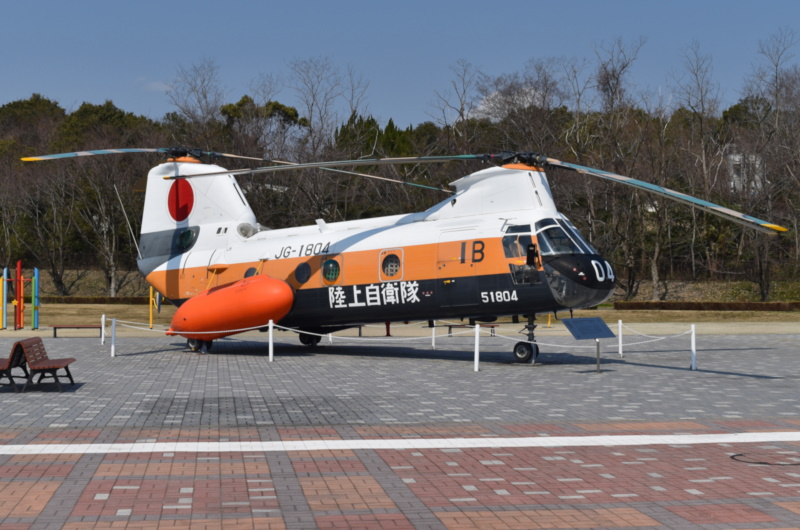
Saudi Arabia took a particular interest in the type, with Kawasaki building 17 "KV-107/IIA-SM" variants for the Saudis, including:
The Saudi machines were delivered in 1979 in a knocked-down form, and were put into operation in 1980. They were regarded as highly satisfactory, with plenty of power for hot-and-high operations. They were fitted with intake sand and dust filters and an external tank on each side of the fuselage.
All the machines were cycled back to Japan for refurbishment beginning in 1987. The refurbishment program took three years. One crashed in 1989 while carrying a sling load; after the load was released, the sling rope snapped back and fouled the rear rotor. All four crew were killed. The surviving helicopters were still in service as of the late 1990s, but they were finally replaced with cheaper helicopters with lower operating costs -- the specifics being unclear.
* The Swedish air force obtained ten Sea Knights in 1962 and 1963, while the Swedish navy obtained three in the same timeframe. These machines were designated "Hkp 4A" and "Hkp 4B" respectively, where "Hkp" was from the Swedish rendering of the word "helicopter". These machines were built by Boeing and were unique variants, featuring large fuel capacity, and fitted with Rolls-Royce Gnome H1200 turboshafts -- the Gnome being a license-built, refined version of the GE T58 -- with 895 kW (1,200 SHP) each, and Decca navigation systems, following their arrival in Sweden.
The Air Force Hkp 4A machines were used for SAR, and featured a retractable rescue hoist in the forward door. The Navy Hkp 4B machines were used for antisubmarine warfare (ASW) and minesweeping. They were fitted with a search radar radome on the end of the tail ramp -- an eccentric place to put a radome, though the radar could be deployed by dropping the tail ramp -- and could carry dipping sonar. Offensive armament consisted of four homing torpedoes, or six depth charges specially designed for shallow water-work.
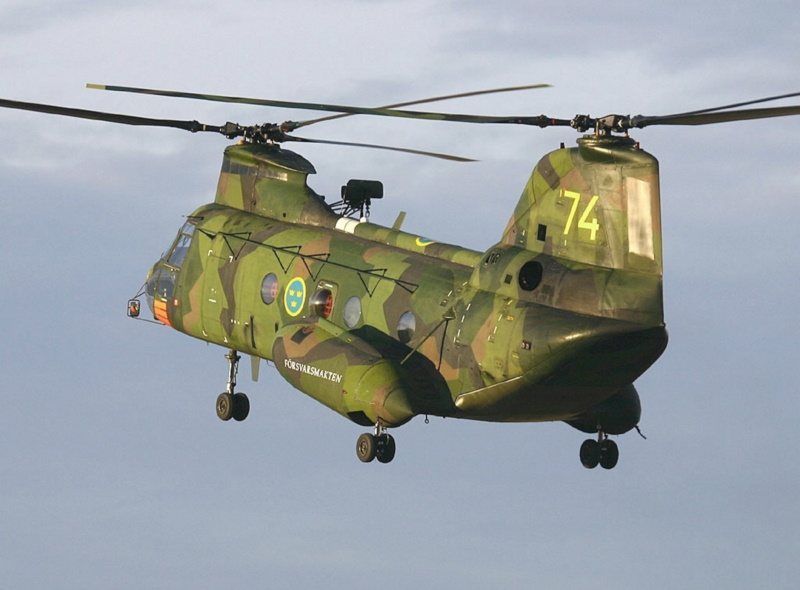
One of the Hkp 4Bs crashed in 1968; Boeing provided a replacement, a refurbishment of a developmental machine. The Swedish Navy obtained eight more KV-107s as "Hkp 4C" helicopters in 1972:1974, with these machines fitted to a similar configuration as the Hkp 4B, but powered by Gnome H1400 turboshafts with 1,045 kW (1,400 SHP) each. These KV-107s were obtained from Kawasaki; since the Japanese constitution places very strong restrictions on export of weapon systems, how they sold these rotorcraft to Sweden is an interesting question. It appears they were sold as civil machines and upgraded to military configuration in Sweden.
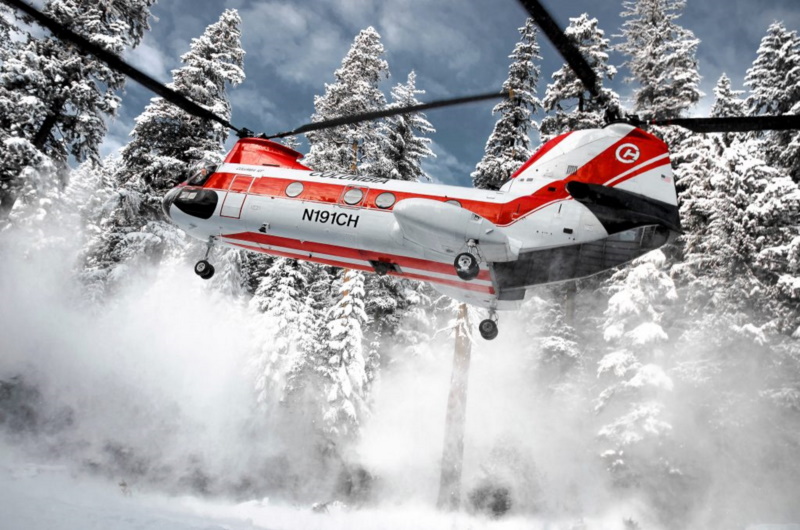
The Swedes consolidated their military helicopter assets into a joint wing in 1998. It seems that a number of Hkp 4As were updated to SAR / ASW configuration as the "Hkp 4D". The last flight of an Hkp 4 was in 2011 -- the survivors being sold to Columbia Helicopters of the USA to be refurbished for commercial service, Columbia obtaining a total of ten machines, as well as the type certificate for the Sea Knight. They were typically fitted for flying crane service, with bulged side cockpit windows, though they could sling-carry a "Bambi bucket" for fire fighting. They remain in very active service, and it appears Columbia has sold some of their Sea Knights to other operators.
BACK_TO_TOP